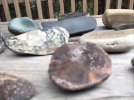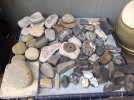My various choppers from Cold Steel/Lasher, Condor, as well as a few older Solingen made ones all have a convex edge or even a full convex grind terminating at ~30 degrees inclusive, and they can all handle that angle very well.
It's also much safer when chopping, as i've found that larger edge angles than that tend to result in glancing blows much more often, which can be very dangerous to yourself and bystanders.
For this reason i want my edges to have a strong tendency to bite at the first chop.
When sharpening i take each edge to arm hair shaving sharp, and although that sharpness level unavoidably wears off, it's both the edge geometry as well as the blade geometry that count.
Some reading material how i do things:
https://www.bladeforums.com/threads/finetuning-a-couple-of-condors.1662592/#post-19189406
https://www.bladeforums.com/threads/optimizing-3-cold-steel-kukri-machetes.1561064/#post-17968792
https://www.bladeforums.com/threads/modding-a-heavy-duty-machete.1564991/#post-19222738




